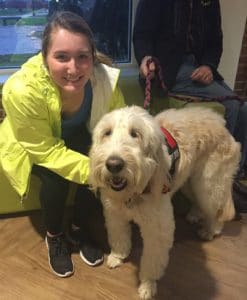Pets help as co-therapists

Ellen Preen, Psy.D, founder and clinical director of Farmington Valley Neuropsychology Associates in Avon, Connecticut
A cat who knows when someone is distressed. A rabbit who bonds with clients more than its owner. A dog who nudges a child who is panicking during a neuropsychological evaluation.
This is the world of the pet co-therapist. From dogs to cats, rabbits, birds, and more, a wide range of animals are being used in offices, on college campus counseling centers, and in grade school settings as part of solution-focused therapy.
Imagine walking into a therapist’s office to be greeted by a wagging tail or a ball of fur waiting for you to give her a lap to snuggle on.
Unless you have allergies or fear of animals, of course, that friendly greeting could feel like a welcoming hug. And, in a world where touching clients is not often recommended, the physicality provided by the warm, furry body of a dog, cat or rabbit can provide a comforting substitute.
“For me, one of biggest issues is touch,” said Kim Tousignant, Psy.D, a clinical psychologist in Bucksport, Maine, who works with her dog, Rex. “It is very healing. He can do that so they get that nurturing feel.”
Research tells us having a pet can lower blood pressure, diminish physical pain, improve cardiovascular health, and even reduce overall medication requirements.
In therapy, children with autism demonstrate stronger communication skills and other clients find stress reduction.
“I gave one girl a math test and her body tensed up and [Shakespeare,] put his head on her lap and she looked at him and then said, ‘okay I got this,'” said Ellen Preen, Psy.D, founder and clinical director of Farmington Valley Neuropsychology Associates in Avon, Connecticut. “She can do the work but anxiety took over.”
“A pet is another tool in therapy,” she added, “like music or art or yoga that can help a patient to gain coping skills.”

Clarissa Uttley, PhD, associate professor and head of the Pet Assisted Therapy program at Plymouth State University
Clarissa Uttley, PhD, is an associate professor and head of the Pet Assisted Therapy program at Plymouth State University, where animals visit with students on campus and also in one-on-one counseling sessions.
Her research over the years has shown how animals help clients open up more in therapy.
“People can be very defensive when talking to another human being,” she said, “but when an animal is involved, they seem to trust the animal and feel more open to talking about issues that are difficult and challenging.”
So, why doesn’t everyone have a pet as co-therapist? How does one go about getting one?
First, it helps if you love animals yourself. In general, these animals are pets who live with the therapists’ families. And they do not always come to the job via the same path. They range from animals like Uttley’s two-year-old rescue rabbit, Sullivan, who shows no love for her owner, but immediately made herself a favorite of clients from the first day.
Her 16-year-old calico cat, Veruca only pays attention to clients who are extremely depressed and Tousignant’s Rex, the 10-year-old Cavalier King Charles dog who has cuddled up to clients since he was a puppy.
Preen’s four-year-old Shakespeare, the English Golden Retriever (hence his name) was originally trained as her daughter’s ADA-compliant therapy dog but found a second calling in working with the children who experienced the traumatic school shooting at Sandy Hook Elementary.
“When I am working with kids in Newtown, there is a lot of survivor guilt,” said Preen. “When they come, I always make sure Shakespeare is with me.”
Beyond practical considerations of having a pet with you, – safety issues, walking and feeding schedules, toys and treats for client interaction, and an insurance rider, there are other questions to be answered before bringing an animal to a therapy session.
First and foremost, would this animal be a good therapist? Does she like interacting with people? Can he settle down during a session? Does she know when she is not wanted, to keep a distance?
“Rex has his favorites and they are the people who love doting on him,” said Tousignant. “But through the years, there have been a couple of clients who did not want to be in session with the dog. So if someone needs a break from him, I move him into other room.”
Not all co-therapists are trained as official “therapy pets,” but basic, solid training for a dog (including crate training) is a must.
With a cat, of course, good luck on doing any training which means that fewer cats would be appropriate for in-office work. But with all that said, the benefits of using pets in therapy could far outweigh the negatives.
“I think as soon as we can feel comfortable including them as partners in the therapy, rather than just seeing them as pets,” said Uttley, “the better it will be for us and for client outcomes. It would help us to reach people easier and make people feel comfortable faster.”

April 24th, 2020 at 6:49 am chuckanderson posted:
chuckanderson posted:
Congratulations Clarissa,you have always been a great advocate for therapy dogs.
Holiday and I always enjoyed visiting students at PSU.Keep up your excellent devotion